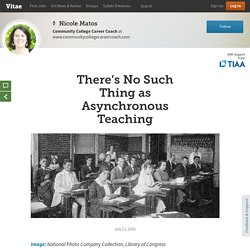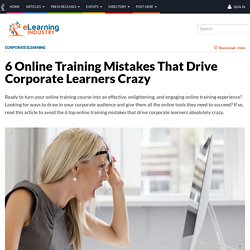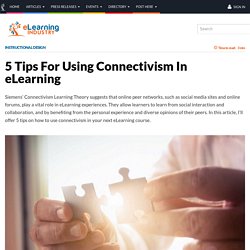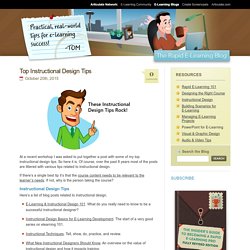

There’s No Such Thing as Asynchronous Teaching. Image: National Photo Company Collection, Library of Congress I’ve been teaching both online and hybrid courses for years at my community college, but last semester marked the first time I taught my entire five-course schedule online.

Again and again, as the semester progressed, my thoughts returned to the issue of time. No, teaching entirely online did not give me more time to myself. Nor did it offer what I could uncomplicatedly call “a more flexible schedule.” But it did profoundly alter my sense of what timing means in the virtual classroom. Ready to Launch: Re-Envisioning the Preparation of Students for Online Learning. —Co-written with Angela Gunder | Senior Instructional Designer, University of Arizona One of the most important questions a university must ask in welcoming new students is how they will orient or onboard incoming cohorts to ensure that the tools, resources and information required for success are adequately provided.

Most traditional face-to-face campuses provide varying iterations of a student welcome, ranging from a few hours to a multi-day event. The University of Arizona is no exception, conducting dozens of orientations over the summer to help residential freshmen acclimate to the university environment, as well as transfer student events catered to those coming from a community college. In Fall 2015, we launched our first fully online undergraduate degree programs.
Resources for Underprepared Students - Online Education Initiative. The Basic Skills Work Group of the OEI is currently focused on identifying “just in time” modules that can be embedded into online courses.

Many of our students arrive on campus not yet academically prepared to succeed in courses. These students often lack the mathematics, reading, writing, English second language, and information competency skills that college faculty expect of incoming “freshmen.” Student Success Resources - Online Education Initiative. Setting expectations and preparing students to make the best possible use of online learning technology is an important best practice.

-Public Policy Institute of California (PPIC) Report, 2015 The Online Education Initiative (OEI) recognizes that increasing student success involves many aspects of student support beyond that provided by the classroom instructor. Many students are unaware when they register for an online course that the environment requires a skill set that is different from what is needed for the traditional classroom experience. Students must not only be self-directed learners, but also manage their time well and navigate a technology-rich environment that goes beyond social media and smartphones. In addition to the resources below, the OEI is working on more ways to assist colleges in directly supporting students, including online counselor support, online proctoring technology, library services and more. Currently available student success resources include:
Open Educational Resources. Informal Learning. Development. Storyboarding. Assessment. Methods, Strategies and Activities. Materials. Media. Editing and Revision. Sharing and Dissemenation. Advantages And Possible Limitations Of Online Learning. Online learning has completely changed the scenery of both academic education and corporate training.

6 Online Training Mistakes That Drive Corporate Learners Crazy. Ready to turn your online training course into an effective, enlightening, and engaging online training experience?

Looking for ways to draw in your corporate audience and give them all the online tools they need to succeed? If so, read this article to avoid the 6 top online training mistakes that drive corporate learners absolutely crazy. Corporate training is not usually considered to be fun and exciting. In fact, most employees would rather sit in traffic or babysit a bunch of unruly grade schoolers instead of participating in an online training session. What does this mean for eLearning professionals?
Thinking that all employees have the same needs, goals, and preferences. The 4 Hottest eLearning Trends For 2016. The Case for Variables in E-Learning. Why should one use variables in elearning, especially since the authoring tools are so easy to use?

Good question. Many course authors transition from facilitated classroom training to elearning development. Their companies buy software and then they’re left on their own to build courses. If you’re using software like Storyline, producing courses is relatively simple. 5 Tips For Using Connectivism In eLearning. Siemens’ Connectivism Learning Theory suggests that online peer networks, such as social media sites and online forums, play a vital role in eLearning experiences.

They allow learners to learn from social interaction and collaboration, and by benefiting from the personal experience and diverse opinions of their peers. In this article, I’ll offer 5 tips on how to use connectivism in your next eLearning course. Experiences is an invaluable part of the learning process, but incorporating real world, hands-on knowledge can be a challenge in eLearning. The Difference Between Knowledge And Skills: Knowing Does Not Make You Skilled. For many people, knowledge and skills are similar concepts used to describe competency.

But for learning professionals they should be considered as two quite different yet related concepts. Knowledge is information acquired through sensory input: Reading, watching, listening, touching, etc. The concept of knowledge refers to familiarity with factual information and theoretical concepts. Knowledge can be transferred from one person to another or it can be self acquired through observation and study. Skills, however, refer to the ability to apply knowledge to specific situations. To make it simple, knowledge is theoretical and skills are practical. The same applies to a job: One can know a lot about a subject matter, but might not have the skills required to apply that knowledge to specific tasks, since knowledge does not provide skills. Developing Skills. Top Instructional Design Tips. At a recent workshop I was asked to put together a post with some of my top instructional design tips.

So here it is. Of course, over the past 8 years most of the posts are littered with various tips related to instructional design. 7 Reasons You Need An Instructional Design Portfolio. The quality of your Instructional Design Portfolio reflects the quality of your work and demonstrates it to anyone looking to hire or commission you. You don’t have a portfolio? Read this article to learn 7 reasons why this is a huge mistake that you need to correct as soon as possible. As an Instructional Designer, there is simply no excuse for not having an Instructional Design portfolio, especially in this day and age, where online portfolios, or portfolio websites, are becoming more and more popular.
An Instructional Design portfolio sums up your work, output, skills, and expertise. It demonstrates your whole creative process; how you work, how you generate ideas, and how you create highly quality eLearning courses. It offers you the opportunity to stand out. Typography In eLearning: 5 Key Tips For eLearning Professionals. Typography is critical for eLearning design and development; it can make your eLearning course look professional and well organized, or amateurish and sloppy. Most importantly, it affects your learners’ attention.
In this article, I’ll share 5 key tips for great typography in eLearning, so that you can make sure that you use it effectively in all of your eLearning courses. If you ask any graphic designer, they will tell you that typography is art; indeed, typographic details have been created from thousands of years of written language and when used effectively they can communicate great beauty. 12 Reasons Every District Should Open a Flex School. Flex model programs or schools have an online curriculum with onsite support. This category of blended learning is more common in high school because it requires a good deal of independent study. The Christensen Institute describes flex models this way: What are some tips for transitioning an offline curriculum into an online course? 'Blended' Learning Shows Promising Results At D.C. Schools. A "blended" learning model, which combines traditional teacher instruction with use of technology, is showing encouraging results at some D.C. public schools.
Some D.C. public schools using the "blended learning model" are seeing student test scores go up and suspensions go down. At Randle Highlands Elementary School in Southeast D.C., fourth grade teacher Jarvis Gause just left the small group of readers he was working with for a moment, and he's checking in on another group wearing headphones, working quietly on computers.
There are different learning "stations" and these 9-year-olds rotate through all of them. It's part of the blended learning model, which blends teacher-led instruction and technology. Principal Tracy Foster says even kindergartners at this school use computers to learn, but they have a picture password because they can't spell yet.
"We have some kids that are reading at the eighth grade level, some kids that are reading at second grade level," Rice says. Pace Yourself! Tips for Maintaining Momentum as You Create Online Courses - SchoolKeep Blog. Posted by Chris Holewski in Educator Tips on September 9, 2014. Benefits of Standardization in E-learning.